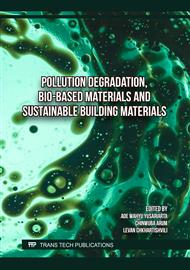[1]
R.I Umasabor, Effect of temperature on the compressive strength of sandcrete blocks. Journal of Engineering for Development. Vol. 15 (1), (2023), pp.171-176.
Google Scholar
[2]
NIS 87, Standards for sandcrete block. Nigerian Industrial Standards. Standard Organisation of Nigeria, Lagos, (2007), p.12.
Google Scholar
[3]
J.J. Marut, J.O. Alaeze, I.C. Obeka, A review of alternative materials for sustainable construction towards sustainable development. Journal of Modern Materials. Vol. 7, (2020), pp.68-78.
DOI: 10.21467/jmm.7.1.68-78
Google Scholar
[4]
WGBC, Bringing embodied carbon upfront, Report World Green Building Council, London, United Kingdom, (2020). https://www.worldgbc.org
Google Scholar
[5]
IPCC Special Report on climate change, degradation, sustainable land management, food security and greenhouse fluxes in terrestrial ecosystems. Inter-governmental Panel on Climate Change (2020), ISBN 978-92-9169-154-8.
DOI: 10.1017/9781009157988
Google Scholar
[6]
P. Wang, H. Liu, H. Guo, Y. Yu, G. Yue, L. Wang. Study on preparation and performance of alkali-activated low carbon recycled concrete: Corn cob biomass aggregate. Journal of Materials and Technology. Vol. 23, (2023), pp.90-105.
DOI: 10.1016/j.jmrt.2022.12.164
Google Scholar
[7]
V.K Patel, R.K. Pathak, V.R. Patel, Effect of corn cob ash and silica fume on properties of high-strength sandcrete. Journal of Cleaner Production, 293, (2021), pp.126-213.
Google Scholar
[8]
ASTM C618-12, Standard specification for pozzolans. American Society for Testing and Materials International, USA (2000), PA: ASTM International. www.astm.org
Google Scholar
[9]
M. Singh, R. Siddique, S. Goyal, Use of waste marble aggregates in sandcrete. Construction and Building Materials, 140, ( 2017), pp.351-358.
Google Scholar
[10]
F.A. Olutoge, O.S. Oyedepo, Mechanical properties of sandcrete made with recycled sandcrete aggregate and pozzolanic materials. Journal of Building Performance, 10(1), (2019), pp.71-81.
Google Scholar
[11]
S. Yusuf, A.A. Hamza, Comparing the compressive strength of six and nine inches hand moulded sandcrete blocks. Journal of Engineering and Applied Sciences.Vol. 3, (2011), pp.64-69.
Google Scholar
[12]
P.N. Kamau, A.A. Ahmed, Experimental evaluation of corn cob ash as a partial cement replacement. International Journal of Advances in Scientific Research and Engineering, 3(2), (2017), pp.33-38.
Google Scholar
[13]
Y. Anjaneyulu, Performance of sandcrete made with waste sandcrete powder and corn cob ash. International Journal of Advanced Research in Engineering and Applied Sciences, 6(8), (2017), pp.42-50.
Google Scholar
[14]
EN 197-1, Specification of ordinary Portland cement. European Standard, British Standard Institution, London, United Kingdom, (2011), ISBN 978-0-539-03842-2.
Google Scholar
[15]
BS EN 12390-3, Testing hardened concrete: Compressive strength of test specimen. British Standard Institution, London, United Kingdom, (2019), ISBN 978-0-580-98442-6.
Google Scholar
[16]
BS 1881-122, Methods of determination of water absorption, British Standard Institute London, United Kingdom, (2011), ISBN 978-0-580-74627-7.
Google Scholar
[17]
ASTM C136, Standard test methods for sieve analysis of fine and coarse aggregate. American Standards of Testing Materials International, West Conshohocken (2014), PA: ASTM International. http://www.astm.org
DOI: 10.1002/ep.670180104
Google Scholar


